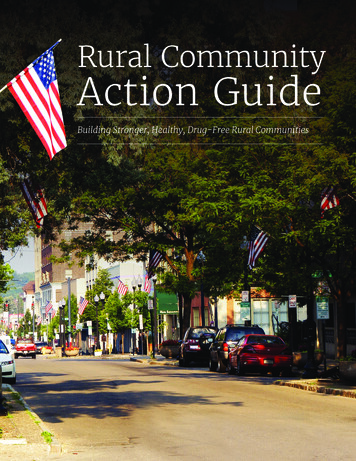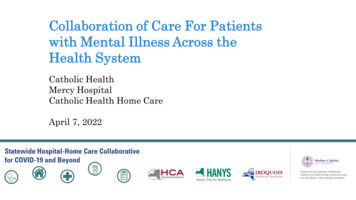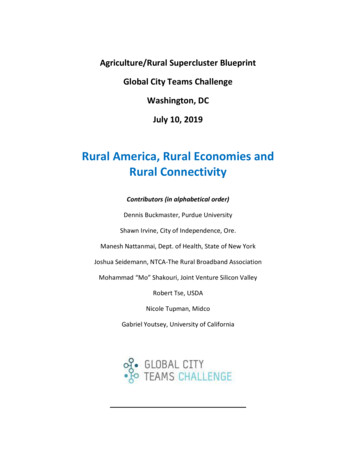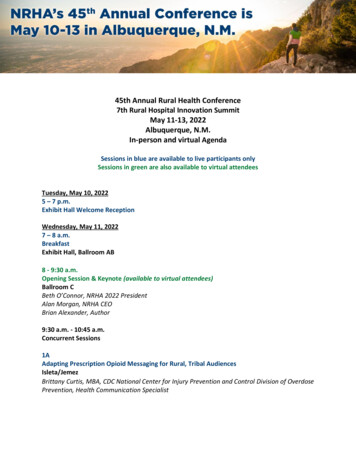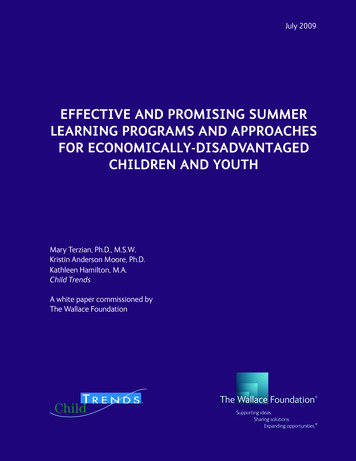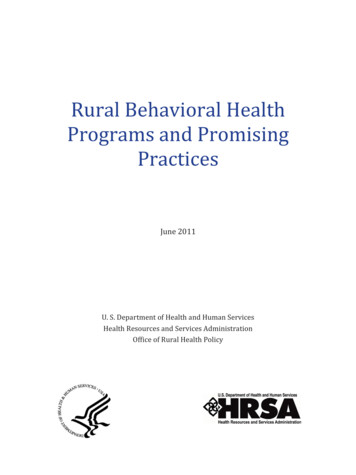
Transcription
Rural Behavioral HealthPrograms and PromisingPracticesJune 2011U. S. Department of Health and Human ServicesHealth Resources and Services AdministrationOffice of Rural Health Policy
Rural Behavioral Health Programs and Promising PracticesThis document was prepared for the U.S. Department of Health and Human Services (HHS), HealthResources and Services Administration (HRSA), Office of Rural Health Policy (ORHP) under HRSAContract # HHSH250200866010C.This publication lists non-Federal resources in order to provide additional information to consumers. Theviews and content in these resources have not been formally approved by HHS. Listing these resources isnot an endorsement by HHS or its components.2
Rural Behavioral Health Programs and Promising PracticesTable of ContentsOverview . 4Introduction . 6Methodology. 8Overview of Nominated Programs . 9Developing a Promising Practice . 11Focused Technical Assistance . 16Conclusions . 21References . 23Appendices. 24Appendix A: Questions included in the Nomination Form . 24Appendix B: Phone Interview Follow-Up Questions . 29Appendix C: Description of Rural Behavioral Health Programs . 30Appendix D: Web site Links . 633
Rural Behavioral Health Programs and Promising PracticesRural Behavioral Health Programs and Promising PracticesOverviewThe U.S. Department of Health and Human Services (HHS), Health Resources and Services Administration (HRSA), Officeof Rural Health Policy (ORHP) coordinates activities related to rural health care within the U.S. Department of Health andHuman Services. ORHP has department-wide responsibility for analyzing the possible effects of policy decisions on 62million residents of rural communities. ORHP was created by Section 711 of the Social Security Act to advise theSecretary of Health and Human Services on health issues within rural communities, including the effects of Medicare andMedicaid on rural citizens’ access to care, the viability of rural hospitals, and the availability of physicians and otherhealth professionals. ORHP administers grant programs designed to build health care capacity at both the local and Statelevels.In particular, the community-based grant programs within ORHP that draw authority from Section 330A of the PublicHealth Service Act, such as the Rural Health Care Services Outreach grant program, are mandated to “expand access to,coordinate, restrain the cost of, and improve the quality of essential health care services, including preventative andemergency services, through the development of integrated health care delivery systems or networks in the rural areasand regions”. As a result of the program’s legislative focus, the Outreach grant program provides funding to consortia forthe direct provision of health care services as well as for community health service collaboration.Currently there are many challenges to providing mental health and substance abuse (behavioral health) care in ruralAmerica. As such, ORHP supported a study in 2008 to examine the barriers to evaluating programs in rural and frontierbehavioral health and to disseminate this information among current grantees and future applicants for the Rural HealthCare Services Outreach, Rural Health Network Development, and Rural Health Network Development Planning programsthat have a focus on behavioral health delivery in rural communities. The intent was to closely examine these programsin a descriptive manner and outline requirements to move these programs/practices to more rigorous scientificvalidation that would be valuable in demonstrating their effectiveness. This document will allow rural behavioral healthprograms to learn from the information gathered in this study and the value of collecting and using data to makeprogram improvements, demonstrate effectiveness and importance of services, and find funding for sustainability.Evidence-based Practices (EBPs) are practices that integrate best research evidence with clinical expertise and patientvalues (Institute of Medicine, 2001). EBPs are increasing in the field of behavioral health: consumers want treatmentswith proven effectiveness; providers want to increase their knowledge to enable provision of those treatments; researchand funding entities look for opportunities to identify new evidence-based treatments; and, in some cases, policymakersare legislating the provision of evidence-based practices (e.g., Oregon Statute 182.525, which mandates expenditures forevidence-based practices).Overall this shift toward the use and development of EBPs in behavioral health services is moving in a positive direction,with the end result being the provision of more effective and standardized behavioral health treatments. However,many of these EBPs are tested in urban areas, and are not easily adapted to rural areas without losing key componentsof the tested practice.Due to the difficulty of developing and evaluating EBPs, the term, “promising practice,” has been used to refer tobehavioral health practices that do not yet have the evidence-base to be considered EBPs, but which appear to beeffective based on a less stringent definition of research evidence (e.g., using a comparison group that is not wellmatched to the treatment group) or preliminary and/or simple data evaluation. The term, “best practice,” is used torefer to a practice which is generally thought to be effective based upon anecdotal evidence, but for which objectivedata is lacking. Without some degree of data and evaluation to support the effectiveness of a practice, it is difficult todevelop an evidence-based practice.4
Rural Behavioral Health Programs and Promising PracticesA practice is defined as a specific procedure that can be generalized to targeted situations. For example, in using aspecific depression screening questionnaire, there are standard procedures to follow (e.g., a specific order of questions,a specific method of scoring the responses). This screening questionnaire may be used in a variety of settings, with avariety of patients, but the reliance on a specific procedure makes it a practice. In contrast, a program encompassesmultiple practices, activities, and strategies. For example, a “Depression Awareness Program” would not onlyincorporate the practice of depression screenings, but would use targeted behavioral health education, outreach, healthfairs, and marketing, which are all part in parcel of a program and specific to the target population. A program may be anEBP, promising, or best practice if program variables can be generalized to different populations and/or settings.Although there are a number of interesting and novel behavioral health practices currently being implemented in ruralAmerica, there are fewer practices that are evaluated and tested for their effectiveness than in urban areas. Much of theevidence for the effectiveness of these practices comes from subjective experience and observation, rather than datatracking and analysis.This report documents a study to identify innovative rural programs (i.e., sets of practices, activities, and strategies), anduses the results to suggest basic tools for rural organizations to embark upon the steps necessary to move a programthat is perceived to be effective into a promising practice. Achieving the status of promising practice is beneficial toprograms because it provides evidence of the program’s effectiveness to a target population and funders who mayinvest in the program, and also enables other rural programs to adapt and use the program in their own community. Thisdocument will provide an overview of tools such as community building, grant-writing, data collection, and programdefinition, which may prove useful to organizations that are interested in transitioning their unique and innovativebehavioral health programs to promising practices.In the initial stage of this study, the Western Interstate Commission for Higher Education (WICHE) Mental HealthProgram identified programs in rural behavioral health. WICHE staff spoke with 62 rural behavioral health and substanceabuse providers around the country who had developed novel and innovative programs to improve behavioral healthservices in rural areas. Although most programs collected some form of data, few programs utilized those data todetermine their programs’ effectiveness. Over the course of these interviews, most organizations reported needingadditional resources and knowledge in order to evaluate the effectiveness of their programs. Many programs reported a lack of staff time and funding to support program evaluation and/or researchactivities. Overworked staff members are unable to set aside time for data-related activities, such as thedevelopment of data collection procedures, data collection itself, and data analysis. In addition, staff membersdo not have time to document program-related activities, or apply for funding to support program andevaluation activities. Finding assistance from outside researchers with expertise in research design, data collection, and programevaluation is also a challenge, as most programs do not have the financial resources to support externalconsultants. Thus, rural organizations wishing to evaluate the effectiveness of a program are in a double bind –they often do not have the time to develop a data collection and evaluation procedure, and also do not havefinancial resources to hire anyone to assist with this process. Even if programs do have the staff time to devote to evaluation activities, they often do not have the expertiseto carry out those activities. Providers in general, and rural providers specifically, are often not trained inresearch design, data collection and analysis, and program evaluation. In addition, providers often do not haveknowledge or experience with grant-writing (e.g., where to identify grant opportunities, how to apply for them,and how to write grant applications). Without successful grant-writing opportunities, it becomes nearlyimpossible to fund research and evaluation efforts.5
Rural Behavioral Health Programs and Promising Practices A further hurdle in a program’s ability to become a promising practice is the lack of understanding as to whatconstitutes a practice. Ten percent of organizations (7) responded to WICHE’s initial call for nominations bysending information about the organization as a whole; nominating a group of providers or a facility rather thana method of providing treatment or in some way ameliorating the problems facing individuals who needbehavioral health services in underserved rural areas. Some programs cannot reach the status of promisingpractice not only because they do not have data, but also because of a lack of understanding as to whatconstitutes a practice.This document is primarily targeted toward providers, but is meant to apply to a range of individuals: Providers can learn about data collection and analysis, community engagement, and grant-writing. Policy makers can learn what rural organizations need to implement and develop promising practices, and howthis information is instructive for legislative changes to support these efforts. Researchers can learn what providers need in the way of research tools to enable effective evaluation of ruralpractices (e.g., survey design assistance). Consumers can learn what to look for in order to evaluate whether a given practice is effective in their treatmentand whether it would be a good fit for their behavioral health concerns.The intent of this document is to provide a starting point for rural stakeholders to collaborate and ensure innovativepractices demonstrate effectiveness based on sound science and have the funding necessary to sustain their activities.IntroductionMental illnesses affect up to 1 in 5 individuals in the United States (U.S. Department of Health and Human Services,1999). When compared to major physical illnesses, such as cardiovascular diseases, cancer, respiratory conditions, andinfectious diseases, mental illness ranks second in the calculated burden of disease (i.e., the number of years of life lostto premature death and years lived with the disability; Murray & Lopez, 1996). While often perceived to have minimalinfluence on an individual’s life, mental illnesses are severely disabling. The disability associated with major depression isequivalent to the disability associated with blindness or paraplegia, and the disability associated with active psychosesseen in schizophrenia is equal in burden to quadriplegia (U.S. Department of Health and Human Services, 1999). A recentreport by the World Health Organization (2008) indicates mental illnesses are the biggest health burden in NorthAmerica, largely due to disability which results in a loss of productive years of life.Behavioral Health in Rural AmericaApproximately 20 percent of the United States population is affected by behavioral health issues each year (Kessler etal., 2004), and although the rate of behavioral health problems does not differ substantially between rural and urbanareas, the experience of mental illness differs dramatically (Mohatt, Adams, Bradley, Morris, 2005). The prevalence ofand entry into care for behavioral health problems is generally comparable in rural and urban populations, but thequality of care that rural patients receive for behavioral health problems may be poorer, particularly for residents inoutlying rural areas (Fortney, Rost, & Zhang, 1999; Kessler et al., 2004). Rural Americans with behavioral health disordersare significantly less likely to receive any type of treatment for their behavioral health problems than urban andsuburban Americans (Wang, Lane, Olfson, Pincus, Wells, & Kessler, 2005). Individuals living in rural areas are significantlyless likely than their urban counterparts to receive specialty behavioral health care (Wang, et. al. 2005) and more likelyto receive general medical care only or human services only (e.g., pastoral counseling) (Wang, Demler, Olfson, Pincus,Wells, & Kessler, 2006). Unfortunately, the likelihood of receiving minimally adequate behavioral health care in thegeneral medical sector and human services sector is substantially lower than in the specialty behavioral health sector(Wang, et. al. 2005).6
Rural Behavioral Health Programs and Promising PracticesFor the past 40 years, 60 percent of rural America has been underserved for behavioral health needs (New FreedomCommission on Mental Health, 2003), and more than 85 percent of the nation’s behavioral health professional shortageareas are located in rural America (Bird, Dempsey, & Hartley, 2001). Individuals living in rural communities are faced withthree distinct burdens to adequate behavioral health care: accessibility, availability, and acceptability (Mohatt et al.,2005; New Freedom Commission on Mental Health, 2003). In terms of accessibility, rural residents typically do not knowwhen they need behavioral health care, where they can find that care, and what care options are available to meet theirbehavioral health needs (New Freedom Commission on Mental Health, 2003). When they do find behavioral health care,it is not uncommon for individuals in rural areas to travel hundreds of miles to access those services. The availability ofbehavioral health providers in rural areas is too limited to support urban models of service delivery, in which individualsneeding behavioral health services have a variety of behavioral health providers from which to choose. In addition tophysical barriers to behavioral health care, rural residents also face psychological barriers. Many Americans attachstigma to having or seeking help for behavioral health problems. This stigma is particularly detrimental in rural areaswhere there is little to no anonymity in seeking behavioral health services (Mohatt et al., 2005). These psychologicalbarriers severely limit the acceptability of behavioral health services in rural areas.Challenges Confronting Rural Evidence-Based PracticesThe behavioral health care barriers faced by rural Americans make behavioral health care delivery in rural areassubstantially different than in urban areas, which is a particular challenge for creating evidence-based practices for anddelivering evidence-based practices to rural residents. In recent years, evidence-based practices (EBPs) have emerged asa means to ensure quality behavioral health care among individuals suffering from mental illnesses. EBPs have beenextremely successful in treating mental illnesses. However, most EBPs are developed in urban areas and tested on urbanresidents, with little, if any, thought given to how they might be implemented in rural areas where resources are muchscarcer. The drastic differences in behavioral health care availability, accessibility, and acceptability between rural andurban residents make it challenging to conduct many EBPs in rural areas, leading to a strong need to develop ruralspecific EBPs, and/or determine whether and how existing EBPs can be modified to produce similar treatment effects inrural areas as are observed in urban areas.Unfortunately, a majority of rural areas lack the resources needed to develop and sustain rural-specific EBPs. Rural areasare already underserved and underfunded, and most rural behavioral health professionals do not have the time ortraining to plan and conduct clinical trials, or to analyze and document results from scientific studies. Even with time andexpertise available to carry out and document scientific studies of rural-specific practices, rural behavioral healthservices often do not have the funds to carry out pilot studies necessary for obtaining larger grants. In many rural areas itis therefore a challenge to carry out large-scale clinical trials necessary to test the effectiveness of rural programs. Inaddition, few agencies provide funding opportunities to individuals outside of academic centers, which once again putsrural areas at a disadvantage for developing new EBPs specific for rural areas, or ensuring EBPs are effectively adaptedfor rural areas.The fact that rural behavioral health providers do not have many resources to implement EBPs, or to develop new EBPsleaves rural providers facing a real challenge to providing EBPs for rural residents. However, many rural providers havedeveloped programs specific to their areas, which may be quite successful in improving the availability, accessibility, andacceptability of behavioral health services in rural areas. Rural providers are in a better position to understand theunique needs of their communities, and many have adapted their programs and treatments to meet those needs.Unfortunately there is no medium for sharing this knowledge, and it often remains isolated in specific communities, withfew resources available for documenting and publicizing the effectiveness of these unique rural programs.7
Rural Behavioral Health Programs and Promising PracticesGoalsIn response to the need for technical assistance in determining a program’s effectiveness, WICHE conducted a study toa) identify rural programs that were attempting to meet a behavioral health need in a rural area, and b) determine thegeneral resources these programs needed to move their programs toward promising practices. This process included asolicitation for nominations via a web-based survey, and follow-up interviews with key individuals from each program.The end result of this process is a snapshot of approximately 60 rural behavioral health programs throughout thecountry, and a more detailed understanding of what rural programs need to do to become promising practices.MethodologyThe identification of rural behavioral health programs involved a multi-step process that first solicited nominations fornovel and innovative programs, and then collected additional information about the programs through a survey andfollow-up interviews. Below, is a discussion of the procedure for soliciting nominations, surveying, and interviewing eachof these programs.Reaching Programs/PracticesCriteria were not given for the type of programs to nominate for inclusion in this study (e.g., hotline, outreach), otherthan the criteria that the program have a positive impact on the behavioral health of individuals living in rural areas.Nominations were solicited via e-mail announcements distributed to national rural health organizations (the NationalAssociation for Rural Mental Health, the National Association for Rural Health, the National Association of State MentalHealth Program Directors), national rural behavioral health funding agencies (Substance Abuse and Mental HealthServices Administration, Health Resources and Services Administration), as well as organization-specific contacts such asthe Rural Assistance Center and the WICHE Mental Health Program. The purpose of these e-mails was to ensure broaddistribution of the announcement to rural consumers, providers, and policy makers.The announcement stated the goal of the survey was to identify practices that were successful in meeting a behavioralhealth need in a rural area. The definition of "meeting a behavioral health need in a rural area" was purposefully vague.Potential respondents were informed “meeting a need" could include increasing access to and/or availability ofbehavioral health services, increasing awareness about behavioral health issues, recruitment and/or retention ofbehavioral health providers, treatment of a behavioral health problem, and prevention services, among others. Thediversity of programs responding to the nomination indicates there are very diverse behavioral health needs in ruralareas, and a large number of ways to meet those various needs.The SurveyIndividuals who nominated programs by responding to the survey answered a series of questions designed to create acomprehensive summary of the program, and determine whether the programs had any data on their effectiveness. Thesurvey is included as Appendix A and included categories of questions such as: contact information, characteristics of thenominated program, characteristics of the targeted population, training of staff, documentation of program-relatedinformation, and data collection/research capacity.8
Rural Behavioral Health Programs and Promising PracticesPhone InterviewsPhone interviews were conducted with 62 organizations that completed the survey, to collect more information on thenominated programs. Organizations that started but did not complete the survey, or did not respond to requests forphone interviews, were not interviewed. The interviews focused on further understanding the programs, and includedadditional questions, such as those directed at the sustainability of the program, and its uniqueness. The list of questionsused for these phone interviews appears in Appendix B. In addition to these standard questions, phone interviews alsoincluded program-specific questions whose goal was to clarify responses given on the survey.Site VisitsEleven programs were selected for site visits by the project team and project officer at the Office of Rural Health Policy.In cases where the program was confined to one location, these site visits included an in-person tour of the program andmeetings with essential program staff. In cases where the program was more distributed, a phone call was conducted,including as many staff members as possible. The goal was simply to get a broader picture of the programs by speakingwith people not on the initial phone interviews (providers, directors, consumers) and to visit the program sites.Programs were selected for site visits based on geographical distribution, as well as the type of program it represented(e.g., hotline, integrated care clinic, etc.). The goal of the site visit selection process was to gain an in-depth view of avariety of programs throughout all regions of the country. Therefore, a geographically and topically diverse set ofprograms was selected for the site visits.Overview of Nominated ProgramsSixty-nine programs from across the country completed the initial survey. The programs, representing 32 States, werespread across all four Census regions, and all nine Census divisions. Figure 1 shows the locations of these programs (notethat some locations nominated more than one program, so there are fewer than 69 locations in the figure). Althoughthere are likely substantially more behavioral health programs in the U.S. specifically designed to serve rural areas, thefact that respondents represented all areas of the country suggests the programs described in this document aresomewhat representative of the types of rural behavioral health programs implemented in rural areas.Figure 1: Locations of organizations that completed the initial survey9
Rural Behavioral Health Programs and Promising PracticesCategorization of NominationsAfter learning about the nominated programs, it became clear they fell into one of eleven categories, based on the typeof program and/or population being served. Some programs fell under more than one category, but all were able to beencompassed by the categories below. Programs adapting EBPs for rural areas found ways to carry out existing EBPs in rural areas, despite beingunable to replicate programs with full fidelity. Community education and outreach programs educated individuals in the community about behavioral healthissues. Court teams aimed to keep individuals with behavioral health issues from returning to the justice system. Crisis services programs provided care in some way for acute behavioral health problems. Hotline programs used telephone services to provide support to rural residents with behavioral health concernsor issues. Integrated care programs blended physical and behavioral health services in some way. Peer support programs used peers to provide basic treatment or support to individuals with mental illnesses. Programs serving special populations targeted interventions to a particular population, such as children or theelderly. Telemental health programs used phone or video conferencing to provide behavioral health treatment. Training programs educated future rural behavioral health providers.Themes of Robust ProgramsAfter reviewing the survey responses, talking with programs, and conducting the site visits, a few themes emerged asbeing indicative of a program’s success and ability to serve its rural community. Each of these themes is described,below. These themes are used in the program descriptions in Appendix C to highlight each program’s particularstrengths, and are also expanded upon in the next section, to describe how rural organizations in general can strengthentheir programs in each of these areas in an effort to develop their unique practices into promising practices. Theinterview and selection process led to insights into how programs can excel in each of these areas, and begin to developthe data collection and evaluation tools needed to become a promising practice.Relevance to RuralA program’s relevance reflects its specificity to a rural community. Some programs bring much-needed services to ruralareas, but it is unclear whether the programs were designed for or adapted to the rural area. A program successful in itsrelevance to rural communities develops a program specific for a rural community, or implements an establishedprogram in a way that is specifically adapted for a rural community.Impact on RuralA program that increases the availability, accessibility, and/or acceptability of behavioral health services in rural areashas a successful impact on rural communities. A program with high impact on rural is addressing one or more of thebarriers to behavioral health services in rural communities.Sustainability and Expansion CapabilitySustainability and expansion capability reflects the awareness of and ability to acquire long-term funding for theprogram. Rural programs are dependent on a sustainable and expandable source of funding for their programs. Somehighly promising rural programs cannot continue or expand due to lack of funding. One feature of programs that aresuccessful in meeting a rural need is a reliance on multiple funding sources, and creativity in seeking and obtaining newfunding.10
Rural Behavioral Health Programs and Promising PracticesCapacityA program’s cap
behavioral health practices that do not yet have the evidence-base to be considered EBPs, but which appear to be effective based on a less stringent definition of research evidence (e.g., using a comparison group that is not well-matched to the treatment group) or preliminary and/or simple data evaluation. The term, "best practice," is used to
